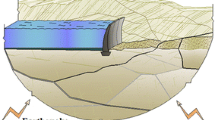Abstract
This study aims to analyze seismic damage of reinforced outlet piers of arch dams by the nonlinear finite element (FE) sub-model method. First, the dam–foundation system is modeled and analyzed, in which the effects of infinite foundation, contraction joints, and nonlinear concrete are taken into account. The detailed structures of the outlet pier are then simulated with a refined FE model in the sub-model analysis. In this way the damage mechanism of the plain (unreinforced) outlet pier is analyzed, and the effects of two reinforcement measures (i.e., post-tensioned anchor cables and reinforcing bar) on the dynamic damage to the outlet pier are investigated comprehensively. Results show that the plain pier is damaged severely by strong earthquakes while implementation of post-tensioned anchor cables strengthens the pier effectively. In addition, radiation damping strongly alleviates seismic damage to the piers.
Similar content being viewed by others
References
Alembagheri M and Ghaemian M (2013), “Damage Assessment of a Concrete Arch Dam through Nonlinear Incremental Dynamic Analysis,” Soil Dynamics and Earthquake Engineering, 44: 127–137.
Bayraktar A, Sevim B and Altunisik AC (2011), “Finite Element Model Updating Effects on Nonlinear Seismic Response of Arch Dam-reservoir-foundation Systems,” Finite Elements in Analysis and Design, 47(2): 85–97.
Bogdanovich AE and Kizhakkethara I (1999), “Threedimensional Finite Element Analysis of Double-lap Composite Adhesive Bonded Joint Using Sub-modeling Approach,” Composites Part B: Engineering, 30(6): 537–551.
Chopra AK (2012), “Earthquake Analysis of Arch Dams: Factors to Be Considered,” Journal of Structural Engineering-ASCE, 138(2): 205–214.
Ciptokusumo J, Weide-Zaage K and Aubel O (2009), “Investigation of Stress Distribution in via Bottom of Cu-via Structures with Different via Form by Means of Sub-modeling,” Microelectronics Reliability, 49(9): 1090–1095.
Dassault Systèmes Simulia (2009), ABAQUS Analysis User’s Manual Version 6.9, Providence, RI, USA.
DL5073-2000 (2000), Specification of Seismic Design of Hydraulic Structures, China Electric Power Press, Beijing, China.
Federal Energy Regulatory Commission (1999), “Arch Dams,” in Engineering Guidelines for the Evaluation of Hydropower Projects, Chapter 11, Washington, DC 20426, USA.
Giglio M (1999), “FEM Sub-modelling Fatigue Analysis of a Complex Helicopter Component,” International Journal of Fatigue, 21(5): 445–455.
Hariri-Ardebili MA and Mirzabozorg HA (2013), “A Comparative Study of Seismic Stability of Coupled Arch Dam-foundation-reservoir Systems Using Infinite Elements and Viscous Boundary Models,” International Journal of Structural Stability and Dynamics, 13(6): 1350032.
Krishnan VR, Hui CY and Long R (2008), “Finite Strain Crack Tip Fields in Soft Incompressible Elastic Solids,” Langmuir, 24(24): 14245–14253.
Kuntiyawichai K and Burdekin FM (2003), “Engineering Assessment of Cracked Structures Subjected to Dynamic Loads Using Fracture Mechanics Assessment,” Engineering Fracture Mechanics, 70(15): 1991–2014.
Kuo J (1982), “Fluid-structure Interactions: Added Mass Computations for Incompressible Fluid,” Report No. UCB/EERC-82/09, University of California Earthquake Engineering Research Center, Berkeley.
Lee JL and Fenves GL (1998), “Plastic-damage Model for Cyclic Loading of Concrete Structures,” Journal of Engineering Mechanics-ASCE, 124(3): 892–900.
Li DY, Tu J and Ouyang JH (2013), “Nonlinear Seismic Response Analysis on Xiluodu Arch Dam with Orifices and Piers,” Journal of Hydraulic Engineering, 44(11): 1366–1371. (in Chinese)
Li TC, Yan YY and Zhao LH (2008), “FEM Analysis of the Orifice Anti-seismic Reinforcement for High Arch Dam,” Proceedings of the 14th World Conference on Earthquake Engineering, Paper No. S13-075, Beijing, China.
Liu J and Li B (2005), “A Unified Viscous-spring Artificial Boundary for 3-D Static and Dynamic Applications,” Science in China Series E: Engineering & Materials Science, 48(5): 570–584
Long YC, Zhang CH and JIN F (2008), “Numerical Simulation of Reinforcement Strengthening for High-Arch Dams to Resist Strong Earthquakes,” Earthquake Engineering and Structure Dynamics, 37: 1739–1761.
Lucht T (2009), “Finite Element Analysis of Three Dimensional Crack Growth by the Use of a Boundary Element Sub Model,” Engineering Fracture Mechanics, 76(14): 2148–2162.
Mao C, Ricles J, Lu LW and Fisher J (2001), “Effect of Local Details on Ductility of Welded Moment Connections,” Journal of Structural Engineering, 127(9): 1036–1044.
Mircevska V, Nastev M, Hristovski V and Bulajic I (2014), “Arch Dam-fluid Interaction Considering Reservoir Topology,” Journal of Earthquake Engineering, 18(7): 1083–1101.
Pan JW, Zhang CH, Wang JT and Xu YJ (2009), “Seismic Damage-cracking Analysis of Arch Dams Using Different Earthquake Input Mechanisms,” Science in China Series E: Technological Sciences, 52: 518–529.
Song LF, Wu MX, Wang JT and Xu YJ (2014), “FE Sub-model Method for Seismic Response Analysis of Orifice Region in Arch Dams,” Journal of Hydroelectric Engineering, 33(3): 216–222. (in Chinese)
Wang GL, Pekau OA, Zhang CH and Wang SM (2000), “Seismic Fracture Analysis of Concrete Gravity Dams Based on Nonlinear Fracture Mechanics,” Engineering Fracture Mechanics, 65: 67–87.
Wang JT, Lv DD, Jin F and Zhang CH (2013), “Earthquake Damage Analysis of Arch Dams Considering Damwater-foundation Interaction,” Soil Dynamics and Earthquake Engineering, 49: 64–74.
Zhang CH and Jin F (2008), “Seismic Safety Evaluation of High Concrete Dams Part I: State of the Art Design and Research,” Proceedings of the 14th World Conference on Earthquake Engineering, Paper No. S13-080, Beijing, China.
Zhong H, Lin G, Li X and Li J (2011), “Seismic Failure Modeling of Concrete Dams Considering Heterogeneity of Concrete,” Soil Dynamics and Earthquake Engineering, 31: 1678–1689.
Author information
Authors and Affiliations
Corresponding author
Additional information
Supported by: National Natural Science Foundation of China under Grant Nos. 51179093 and 91215301, and Specialized Research Fund for the Doctoral Program of Higher Education under Grant No. 20130002110032
Rights and permissions
About this article
Cite this article
Song, L., Wu, M., Wang, J. et al. Seismic damage analysis of the outlet piers of arch dams using the finite element sub-model method. Earthq. Eng. Eng. Vib. 15, 617–626 (2016). https://doi.org/10.1007/s11803-016-0348-7
Received:
Accepted:
Published:
Issue Date:
DOI: https://doi.org/10.1007/s11803-016-0348-7




